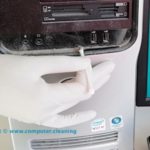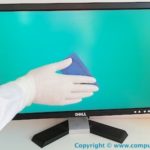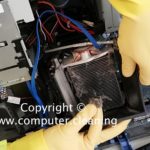Cleaning, sanitizing, and disinfecting in ECE reduces the risk of infectious disease and removes allergens and irritants that cause or trigger asthma and allergies. But many cleaners, sanitizers, disinfectants, and fragrances, even those marketed as “green”, can pollute the air, water, and soil.
These products are washed down the drains of our child care facilities, schools, homes, and workplaces. They make their way in wastewater to the treatment plant where wastewater is treated. During the treatment, sewage is separated into treated wastewater and sludge. Treated water is then discharged into our groundwater, rivers, lakes, and oceans. Many of these waterways supply drinking water to our communities. The problem is that wastewater treatment plants were not designed to remove these chemicals. It is important to think twice before washing or flushing anything down the drain that can harm the environment. Choosing the products you use in your indoor environments carefully can help protect the environment as well as your health. Below we describe two examples of products that are harmful to the environment.
Triclosan in the environment
Triclosan and its relative triclocarban are antimicrobial chemicals that slow or stop the growth of bacteria, fungi, and mildew. They are found in antibacterial soaps, deodorants, sponges, and household cleaners and disinfectants. Over 1 million pounds of triclosan and triclocarban are disposed of in the environment every year. The transport of triclosan to wastewater treatment plants occurs when people;
- wash hands with antibacterial soap
- hand-wash dishes with antibacterial dish soap;
- use personal care products such as toothpaste that contain triclosan;
- use products like cutting boards that contain triclosan.
As a result, triclosan ends up in our drains, sewage systems, and eventually our waterways. It also gets concentrated in the sludge created in wastewater treatment plants. Over 400,000 pounds of triclosan and triclocarban are spread on agricultural fields in the U.S. every year when this waste treatment sludge is recycled as “fertilizer.” Scientists are concerned that plants that grow in the soil contaminated with triclosan from sludge will absorb the triclosan. In experiments, researchers have found triclosan in carrots, pumpkins, and zucchini – foods that are normally good for children. Triclosan is also found in lakes, rivers, ocean coastal waters, domestic and drinking water, soils, indoor dust, fish and other aquatic animals, and humans. Eating fish and fruits and vegetables that contain triclosan is another way humans may be exposed. Research shows triclosan is present in human urine, blood, and breast milk.
Sometimes the risks of using a chemical are balanced by the benefits. But the Food and Drug Administration (FDA) says that triclosan is no more effective at killing germs than washing well with soap and water. According to the Centers for Disease Control and Prevention (CDC), vigorous handwashing in warm water with plain soap for at least 20 seconds is sufficient to fight germs in most cases. When soap and water are not available, use of an alcohol-based hand sanitizer product is a better option than soap that contains triclosan.
Many authorities, including the American Medical Association (AMA), now recommend that triclosan should not be used in consumer products. The health and environmental risks of triclosan are not worth the very limited benefits.
Fragrances in the environment
Fragrances are chemicals that are in most cleaning, sanitizing, and disinfecting products. They
- react with sunlight to contribute to smog formation in indoor and outdoor air;
- may affect water quality when they are used in liquid products like cleaning and personal care products.
Like triclosan, many fragrance chemicals are not filtered out by water treatment. What goes down the drain ends up in our drinking water and in our lakes, streams, rivers, and bays. These compounds;
- break down slowly in the environment;
- are found in the water supply, leading to high levels in nearly all fish, shellfish, and other aquatic wildlife;
- are concentrated in larger animals when larger fish and other wildlife eat contaminated aquatic wildlife. From there, these pollutants travel up the food chain to human beings.





